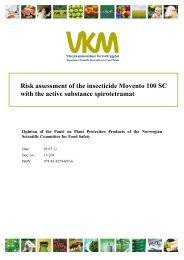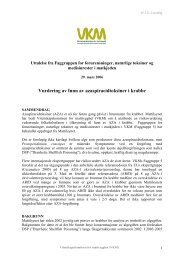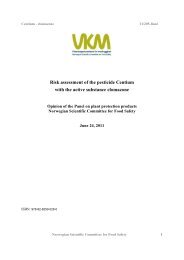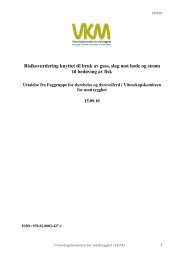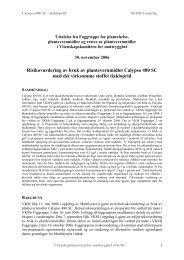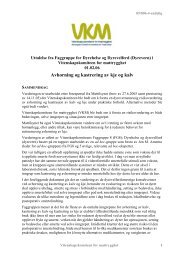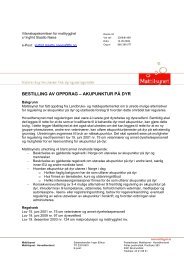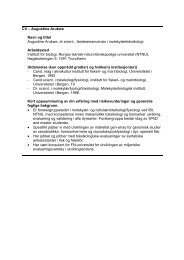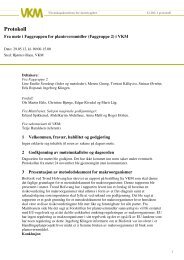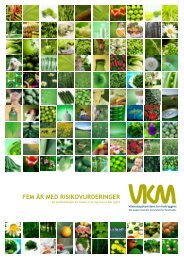Pest risk assessment of the Cucumber green mottle
Pest risk assessment of the Cucumber green mottle
Pest risk assessment of the Cucumber green mottle
You also want an ePaper? Increase the reach of your titles
YUMPU automatically turns print PDFs into web optimized ePapers that Google loves.
07/207-4 FinalOpinion <strong>of</strong> <strong>the</strong> Panel on plant health <strong>of</strong><strong>the</strong> Norwegian Scientific Committee for Food Safety12.02.08<strong>Pest</strong> <strong>risk</strong> <strong>assessment</strong> <strong>of</strong> <strong>the</strong> <strong>Cucumber</strong> <strong>green</strong> <strong>mottle</strong> mosaic virusin NorwaySUMMARYIn 2007, after many years <strong>of</strong> absence, <strong>Cucumber</strong> <strong>green</strong> <strong>mottle</strong> mosaic virus (CGMMV)reoccurred in Norwegian cucumber production. The Norwegian Authority for Food Safety isconsidering whe<strong>the</strong>r or not to regulate CGMMV as a quarantine pest. On this basis <strong>the</strong>Authority, in a letter <strong>of</strong> 20 July 2007, requested a PRA on CGMMV in Norway. To answer<strong>the</strong> request from <strong>the</strong> Authority, <strong>the</strong> Norwegian Scientific Committee for Food Safety (VKM)commissioned a draft PRA report from Bi<strong>of</strong>orsk Plant Health and Plant Protection Division.VKMs Panel on Plant Health (Panel 9) has used <strong>the</strong> report as a basis for <strong>the</strong>ir opinion.Panel 9 gives <strong>the</strong> following main conclusions <strong>of</strong> <strong>the</strong> PRA: 1) Both recent and previouspresences <strong>of</strong> CGMMV in <strong>the</strong> PRA area indicate that <strong>the</strong> pest is able to establish itself in <strong>the</strong>PRA area. Successful establishment <strong>of</strong> CGMMV has only been recorded in <strong>green</strong>houses in<strong>the</strong> PRA area. The probability for establishment and damage in field production is regarded aslow. 2) CGMMV has probably not been present in Norwegian cucumber production since1983, and <strong>the</strong> four cases found in <strong>green</strong>house production in 2007 should be regarded as newintroductions. CGMMV should currently be regarded as <strong>of</strong> limited distribution and undervoluntarily eradication. 3) The most probable pathway for long distance spread into Norwayis seed transmission. Infected seedlings, people, water and soil are more probable pathwaysfor short distance spread. The probability <strong>of</strong> fur<strong>the</strong>r spread from location to location is high.4) Due to <strong>the</strong> potential for high yield loss in modern cucumber production, rapid spread whenfirst introduced and <strong>the</strong> difficulties and costs connected to controlling <strong>the</strong> virus, CGMMV is athreat to <strong>the</strong> modern, highly intensive <strong>green</strong>house production <strong>of</strong> cucumber in Norway. Thepotential damage consists <strong>of</strong> yield loss, direct costs in controlling <strong>the</strong> virus (labour, chemicals,and periods with no production) and <strong>the</strong> indirect costs due to difficulties in cooperation witho<strong>the</strong>r growers and uncertainty regarding <strong>the</strong> market situation. 5) Increased waste from <strong>the</strong>cucumber production is a potential negative environmental consequence. 6) Dry heattreatment has probably been <strong>the</strong> most effective measure to prevent <strong>the</strong> spread <strong>of</strong> CGMMV. 7)New cultures must start with healthy seed or healthy seedlings. Tools, trays, or people comingfrom potentially infected <strong>green</strong>houses must be avoided. 8) In <strong>the</strong> case <strong>of</strong> a crop infection,<strong>the</strong>re has to be strict destruction <strong>of</strong> infected plant material, washing and disinfection <strong>of</strong><strong>green</strong>houses, equipment, tools and clo<strong>the</strong>s. It is important to handle healthy plants beforeinfected ones. To safeguard <strong>the</strong> new crop <strong>the</strong>re should be a stop in cucumber productionNorwegian Scientific Committee for Food Safety 1
07/207-4 Finalbefore starting a new cucumber crop. 9) There is a moderate level <strong>of</strong> uncertainty regarding <strong>the</strong>pathway for entry <strong>of</strong> CGMMV into <strong>the</strong> PRA area. There is a low degree <strong>of</strong> uncertaintyregarding <strong>the</strong> pathogen, its survival and its possibility for transmission, establishment andspread in Norwegian <strong>green</strong>house cucumber production. There is a high degree <strong>of</strong> uncertaintyabout whe<strong>the</strong>r CGMMV is able to become established and spread in field cucumbercultivation in <strong>the</strong> PRA area. The degree <strong>of</strong> uncertainty is moderate regarding <strong>the</strong> impact andeconomic lossesKEYWORDSCGMMV, <strong>Cucumber</strong> <strong>green</strong> <strong>mottle</strong> mosaic virus, cucumber, intensive <strong>green</strong>house production,additional artificial light, yield lossASSESSED BYPersons working for <strong>the</strong> Norwegian Scientific Committee for Food Safety(Vitenskapskomiteen for mattrygghet, VKM), ei<strong>the</strong>r as appointed members <strong>of</strong> <strong>the</strong> Committeeor as ad hoc-experts, do this by virtue <strong>of</strong> <strong>the</strong>ir scientific expertise, not as representatives forhis/her employers. The Civil Services Act instructions on legal competence apply for all workprepared by VKM.Panel 9:May Bente Brurberg, Trond H<strong>of</strong>svang, Christer Magnusson, Trond Rafoss, Leif Sundheim(chair), Brita Toppe, Anne Marte Tronsmo, and Bjørn Økland.Scientific coordinator from <strong>the</strong> secretariat: Elin ThingnæsACKNOWLEDGEMENTSVKM has asked <strong>the</strong> Norwegian Institute for Agricultural and Environmental Research(Bi<strong>of</strong>orsk), Plant Health and Plant Protection Division, to make a draft pest <strong>risk</strong> <strong>assessment</strong>(PRA) report on <strong>Cucumber</strong> <strong>green</strong> <strong>mottle</strong> mosaic virus in Norway. VKM has used this report(Blystad et al. 2008) as a basis to answer <strong>the</strong> request from <strong>the</strong> Norwegian Food SafetyAuthority.Dag-Ragnar Blystad, Brita Toppe and Trond Rafoss are acknowledged for <strong>the</strong>ir valuable workwith <strong>the</strong> draft PRA report.Norwegian Scientific Committee for Food Safety 2
07/207-4 FinalCONTENTS1. Background ........................................................................................................................ 52. Terms <strong>of</strong> reference ............................................................................................................. 53. Initiation ............................................................................................................................. 63.1. Initiation points ........................................................................................................... 63.1.1. PRA initiated by <strong>the</strong> review or revision <strong>of</strong> a policy............................................. 63.2. Identification <strong>of</strong> PRA area........................................................................................... 63.3. Information.................................................................................................................. 63.3.1. Previous PRA ....................................................................................................... 63.4. Conclusion <strong>of</strong> initiation............................................................................................... 64. <strong>Pest</strong> <strong>risk</strong> <strong>assessment</strong> ........................................................................................................... 64.1 <strong>Pest</strong> categorization........................................................................................................ 64.1.1. Identity <strong>of</strong> pest, name and taxonomic position .................................................... 64.1.1.1 Name .............................................................................................................. 64.1.1.2 Synonyms ....................................................................................................... 74.1.1.3 Common names.............................................................................................. 74.1.1.4 Taxonomic position........................................................................................ 74.1.1.5 Bayer computer code...................................................................................... 84.1.2 Methods for detection and identification .............................................................. 84.1.2.1 Symptoms in cucumber.................................................................................. 84.1.2.2 Test plants ...................................................................................................... 94.1.2.3 Electron microscopy....................................................................................... 94.1.2.4 Serology ....................................................................................................... 104.1.2.5 Nucleic acid based methods ......................................................................... 104.1.3 Occurrence in Europe.......................................................................................... 104.1.4 Presence or absence in PRA area ........................................................................ 114.1.5 Cases <strong>of</strong> CGMMV in Norway during 2007 ........................................................ 114.1.5.1 Grower A...................................................................................................... 114.1.5.2 Grower B...................................................................................................... 134.1.5.3 Grower C...................................................................................................... 144.1.5.4 Grower D...................................................................................................... 144.1.6 Regulatory status................................................................................................. 154.1.7 Biological characteristics <strong>of</strong> <strong>the</strong> pest................................................................... 154.1.7.1 Interaction host/pest ..................................................................................... 154.1.7.2 Disease cycle................................................................................................ 154.1.7.3 Dissemination............................................................................................... 164.1.7.4 Survival ........................................................................................................ 164.1.7.5 Control.......................................................................................................... 164.1.8 Potential for establishment and spread in PRA area ........................................... 164.1.9 Potential for economic consequences in PRA area............................................. 174.1.9.1 Norwegian cucumber production................................................................. 174.1.9.2 Potential for economic consequences .......................................................... 184.1.10 Conclusion <strong>of</strong> pest categorization ..................................................................... 194.2. Assessment <strong>of</strong> <strong>the</strong> probability <strong>of</strong> introduction and spread ........................................ 194.2.1 Probability <strong>of</strong> entry <strong>of</strong> <strong>the</strong> pest............................................................................ 194.2.1.1 Identification <strong>of</strong> pathways............................................................................ 194.2.1.2 Probability <strong>of</strong> <strong>the</strong> pest being associated with <strong>the</strong> pathway at origin ............ 204.2.1.3 Probability <strong>of</strong> survival during transport or storage ...................................... 20Norwegian Scientific Committee for Food Safety 3
07/207-4 Final4.2.1.4 Probability <strong>of</strong> pest surviving existing pest management procedures ........... 204.2.2 Probability <strong>of</strong> establishment................................................................................ 204.2.2.1 Availability <strong>of</strong> suitable hosts, alternate hosts and vectors in <strong>the</strong> PRA area. 204.2.2.2 Suitability <strong>of</strong> environment............................................................................ 204.2.2.3 Cultural practices and control measures....................................................... 214.2.2.4 O<strong>the</strong>r characteristics <strong>of</strong> <strong>the</strong> pest affecting <strong>the</strong> probability <strong>of</strong> establishment 224.2.3 Probability <strong>of</strong> spread after establishment............................................................ 224.2.3.1 Conclusion regarding endangered areas....................................................... 224.3. Assessment <strong>of</strong> potential economic consequences ..................................................... 224.3.1 <strong>Pest</strong> effects........................................................................................................... 224.3.1.1 Direct pest effects......................................................................................... 224.3.1.2 Indirect pest effects ...................................................................................... 224.3.2 Analysis <strong>of</strong> economic consequences................................................................... 234.3.3 Conclusion <strong>of</strong> <strong>the</strong> <strong>assessment</strong> <strong>of</strong> economic consequences.................................. 244.3.3.1 Endangered area ........................................................................................... 244.4. Degree <strong>of</strong> uncertainty ................................................................................................ 245. Conclusion........................................................................................................................ 256. References ........................................................................................................................ 27Norwegian Scientific Committee for Food Safety 4
07/207-4 Final4.1.1.2 Synonyms<strong>Cucumber</strong> virus 3Cucumis virus 24.1.1.3 Common namesNorwegian: AgurkgrønnmosaikkvirusSwedish: GurkgrönmosaikkvirusDanish: Agurk-grønmosaikkvirusDutch: KomkommerbontvirusEnglish: <strong>Cucumber</strong> <strong>green</strong> <strong>mottle</strong> mosaic virus4.1.1.4 Taxonomic positionGenus: TobamovirusThe genus Tobamovirus has 22 definitive members (Fauquet et al. 2005).Four species in <strong>the</strong> genus Tobamovirus infect plants in <strong>the</strong> family Cucurbitaceae.These are:• <strong>Cucumber</strong> fruit <strong>mottle</strong> mosaic virus, CFMMV. This is a virus described from Israel(Antignus et al. 2001). It is not yet detected in o<strong>the</strong>r countries.• <strong>Cucumber</strong> <strong>green</strong> <strong>mottle</strong> mosaic virus, CGMMV. This was <strong>the</strong> first tobamovirusdescribed as infecting plants in Cucurbitaceae (Hollings et al. 1975). Several strainshave been described. Two former strains are now described as Kyuri <strong>green</strong> <strong>mottle</strong>mosaic virus – see below.• Kyuri <strong>green</strong> <strong>mottle</strong> mosaic virus, KGMMV. This virus was first mentioned as a“cucumber strain” <strong>of</strong> CGMMV in Japan. The “Yodo-strain”, which formerly wasdescribed as CGMMV, is now classified as a strain <strong>of</strong> KGMMV (Francki et al. 1986).• Zucchini <strong>green</strong> <strong>mottle</strong> mosaic virus, ZGMMV. This virus is recently described fromKorea (Ryu et al. 2000).Regarding CGMMV, several strains are described (Hollings et al. 1975, Antignus et al. 2001),but <strong>the</strong> picture can be a bit confusing as some isolates formerly classified as strains are nowregarded as separate virus species.The type strain is <strong>the</strong> most common strain in Europe. This strain does not give fruitsymptoms. The type strain can give local lesions in Chenopodium amaranticolor undercertain growing conditions, but does not infect Datura stramonium and Petunia x hybrida.The “<strong>Cucumber</strong> aucuba mosaic strain” (synonyms are “cucumber virus 4” and “Cucumisvirus 2A”) has also been found in Europe. This strain can give fruit symptoms in cucumberand local lesions in C. amaranticolor, but not symptoms in D. stramonium.The “Watermelon strain” has been described in Japan. This strain also gives local lesions inC. amaranticolor, but not in D. stramonium.Norwegian Scientific Committee for Food Safety 7
07/207-4 FinalJapanese cucumber strain has been described from Japan. This strain gives severe fruitsymptoms in cucumber and local lesions in D. stramonium, but no local lesions in C.amaranticolor. This strain is now classified as a separate species, KGMMV.The formerly described Yodo strain gives severe fruit symptoms in cucumber and locallesions in C. amaranticolor, D. stramonium and P. x hybrida. This strain is now classified asKGMMV-Y (Francki et al. 1986).The “Indian strain” was isolated from bottlegourd(Lagenaria siceraria) in India (Hollings et al. 1975), in which it caused mosaic, growthreduction and yield loss. This isolate is reported to give local lesions in C. amaranticolor,symptomless infection in inoculated leaves <strong>of</strong> D. stramonium and no infection in tobacco orP. x hybrida.Of <strong>the</strong> 22 definitive members in <strong>the</strong> genus Tobamovirus, four have been identified in Norway(Blystad and Mun<strong>the</strong> 1997):• <strong>Cucumber</strong> <strong>green</strong> <strong>mottle</strong> mosaic virus (agurkgrønnmosaikkvirus) in cucumber• Ribgrass mosaic virus (smalkjempemosaikkvirus) in Plantago major• Tobacco mosaic virus (tobakkmosaikkvirus) in petunia• Tomato mosaic virus (tomatmosaikkvirus) in tomato4.1.1.5 Bayer computer codeCGMMV4.1.2 Methods for detection and identification4.1.2.1 Symptoms in cucumberTypical symptoms <strong>of</strong> CGMMV such as mosaic, leaf bubbling, wilting and chlorosis are easilyrecognized, but symptoms on lower leaves and weak symptoms may look like physiologicaldisorders.Norwegian Scientific Committee for Food Safety 8
07/207-4 FinalFigure 1. Symptoms <strong>of</strong> CGMMV consisting <strong>of</strong> mosaic (upper left) (photo: Erling Fløistad), leaf bubbling(upper right) (photo: Dag-Ragnar Blystad), wilting (lower left) (photo: Dag-Ragnar Blystad) and chlorosis(lower right) (photo: Ørjan Omdal).4.1.2.2 Test plantsThe host plant cucumber (Cucumis sativus) can be used as a test plant. The time frominoculation to symptom development is 14 days.CGMMV infects very few <strong>of</strong> <strong>the</strong> commonly used test plants in plant virology. The test plantsC. amaranticolor, D. stramonium, Nicotiana benthamiana and P. x hybrida have been used todescribe and differentiate isolates.4.1.2.3 Electron microscopyThere are relatively high amounts <strong>of</strong> CGMMV particles in <strong>the</strong> plant sap <strong>of</strong> infected leaves.This gives <strong>the</strong> possibility to use negative staining as a rapid method to assess <strong>the</strong> occurrence<strong>of</strong> CGMMV particles. These particles are typical for tobamoviruses with <strong>the</strong> dimensions 300x 18 nm.Norwegian Scientific Committee for Food Safety 9
07/207-4 FinalFigure 2. Tobamovirus particles are easily recognized in sap samples from infected plants. The black linerepresents 200 nm (photo: Dag-Ragnar Blystad).4.1.2.4 SerologyAntisera and ELISA test kits are available from commercial suppliers.4.1.2.5 Nucleic acid based methodsPCR is very sensitive and has been used to detect CGMMV in seeds and soil (Varveri et al.2002).4.1.3 Occurrence in EuropeCGMMV is reported to have occurred in our neighbouring Nordic countries Sweden,Denmark and Finland between 1960 and 1980 (Kristensen 1977, Rydén 1965a, Linnasalmi1966). After that <strong>the</strong> occurrence <strong>of</strong> CGMMV has decreased.A short inquiry among Nordic colleagues during spring 2007 regarding CGMMV cases gave<strong>the</strong> following information: in Finland <strong>the</strong>re was an epidemic in 1968, since <strong>the</strong>n <strong>the</strong> virus hasbeen found in 1987, 1989 and 1990; in Sweden, <strong>the</strong>re was one known case early in <strong>the</strong> 1990s,one case in 2002 and two cases in 2006; in Denmark seven cases have been detected during<strong>the</strong> last few years (Blystad 2007).Regarding strains <strong>of</strong> CGMMV, <strong>the</strong> ordinary strain is <strong>the</strong> only one occurring in Norway and in<strong>the</strong> o<strong>the</strong>r Nordic countries. Rydén (1965a) reported a finding <strong>of</strong> <strong>the</strong> aucuba strain in Swedenin 1965.Norwegian Scientific Committee for Food Safety 10
07/207-4 FinalThe situation in o<strong>the</strong>r European countries is unclear, but some <strong>of</strong> <strong>the</strong> Norwegian extension<strong>of</strong>ficers have <strong>the</strong> impression that CGMMV is occurring in Dutch cucumber production withup to 30-50 % <strong>of</strong> <strong>the</strong> <strong>green</strong>house cultures being infected during <strong>the</strong> year.4.1.4 Presence or absence in PRA areaBefore 1980, CGMMV was regarded as commonly occurring in <strong>green</strong>house cucumber inNorway (Bjørnstad 1970, Bjørnstad 1979). Since <strong>the</strong>n, <strong>the</strong>re was one known case <strong>of</strong> CGMMVin 1983 and no more known cases <strong>of</strong> CGMMV until 2007. The latter outbreak was followedup by a survey, which is reported in <strong>the</strong> following sections. Because successful eradicationhas not been confirmed after <strong>the</strong> 2007 outbreaks, CGMMV should currently be regarded as <strong>of</strong>limited distribution and under voluntarily eradication in <strong>the</strong> PRA area.Altoge<strong>the</strong>r 21 out <strong>of</strong> 62 cucumber producing growers, representing 48 % <strong>of</strong> <strong>the</strong> <strong>green</strong>housecucumber production area, were surveyed during 2007. CGMMV infection was detected atfour growers. Details <strong>of</strong> <strong>the</strong>se cases are described in <strong>the</strong> next section.The area <strong>of</strong> field grown cucumbers is about 80 hectares in Norway, mainly located in ØstfoldCounty (50 hectares) and Aust-Agder County (30 hectares). During August and September2007 <strong>the</strong> cucumber fields <strong>of</strong> altoge<strong>the</strong>r 14 growers in Østfold and 10 growers in Aust-Agder,in total approximately 36 hectares, were surveyed for CGMMV. The fields were inspected forsymptoms and 25 leaf samples from each farm were sent for testing (ELISA) at Bi<strong>of</strong>orsk. Thefarms surveyed represent approximately 50 % <strong>of</strong> <strong>the</strong> area in Østfold and 30-35 % <strong>of</strong> <strong>the</strong> areain Aust-Agder. No suspicious symptoms were seen, and no samples were found to be infectedby CGMMV.4.1.5 Cases <strong>of</strong> CGMMV in Norway during 20074.1.5.1 Grower AThis was <strong>the</strong> first detection <strong>of</strong> CGMMV in Norway in 2007. This grower is located in <strong>the</strong>southwest <strong>of</strong> Norway, and has a year-round cultivation with additional light. All seedlings aregrown in a separate <strong>green</strong>house connected to <strong>the</strong> production <strong>green</strong>houses via a machine andpacking hall. Each cucumber crop is grown for 10 weeks with a high amount <strong>of</strong> additionallight.The grower observed <strong>the</strong> first diseased plants in June 2006, but <strong>the</strong> symptoms (Fig. 3) wereassumed to be caused by physiological factors (light, nutrients etc). It was not realised that itcould be a virus disease until February 2007, when Bi<strong>of</strong>orsk Plant Health and Plant Protectiondiagnosed a sample as CGMMV.Norwegian Scientific Committee for Food Safety 11
07/207-4 FinalFigure 3. Chlorosis (left) and mosaic (right) in CGMMV infected plants at Grower A (left photo: ØrjanOmdal, right photo: Erling Fløistad).The grower had observed up to 70 % infected plants in some holds and claimed to suffer up to30-50 % crop loss. Yield data received in December 2007 showed <strong>the</strong> yield level before <strong>the</strong>eradication (weeks 1 to 9, 2007), <strong>the</strong> eradication period (weeks 10 to 14) and <strong>the</strong> yield levelafter new virus free plants were used in production (from week 15) (Fig 4). This data seem toconfirm <strong>the</strong> grower’s assumption <strong>of</strong> about 50 % yield loss due to CGMMV.All plants were removed from <strong>the</strong> production area, and <strong>the</strong> <strong>green</strong>houses were all washed withhigh pressure water at 40-50°C and <strong>the</strong>n treated with hydrogen peroxide. Before planting, <strong>the</strong><strong>green</strong>house area was sprayed with 5 % citric acid. New crops were started two to four weeksafter cleaning and disinfection.CGMMV has not shown up again, probably due to a strict hygienic regime. After 9 months<strong>the</strong>re is still no new infection <strong>of</strong> CGMMV. The yield <strong>of</strong> cucumber fruits is now 40-50 %higher than before <strong>the</strong> infected plants were eradicated.Norwegian Scientific Committee for Food Safety 12
07/207-4 FinalA new cucumber culture was planted on July 15th. During this culture period, ending in <strong>the</strong>first week <strong>of</strong> November, no plants infected by CGMMV were found, indicating that <strong>the</strong>described control measures had been successful.There are no conclusive yield data from this grower, so it is not possible to measure yield lossdue to CGMMV.Figure 5. Chlorosis (left) and wilting (right) in virus-infected plants at Grower B (photos: Dag-RagnarBlystad).4.1.5.3 Grower CThis grower, located in southwest <strong>of</strong> Norway, has a year round cultivation <strong>of</strong> cucumbers usingadditional lighting. The grower also produces tomatoes and o<strong>the</strong>r crops.<strong>Cucumber</strong> seedlings were bought from Grower A. As diseased plants were observed anddiagnosed at Grower A in February 2007, samples from Grower C were also investigated andCGMMV was found.All cucumber plants were removed and <strong>the</strong> <strong>green</strong>house areas were washed and disinfected,but due to <strong>the</strong> production <strong>of</strong> o<strong>the</strong>r crops, all <strong>the</strong> <strong>green</strong>house areas could not be treated at <strong>the</strong>same time.When new samples were analysed in September 2007, it turned out that CGMMV wasinfecting <strong>the</strong> newly planted cucumber crops.The grower did not succeed to get rid <strong>of</strong> CGMMV during 2007, probably because <strong>of</strong>inadequate disinfection. Because <strong>the</strong> <strong>green</strong>house contained several cultures, it was notpossible to clean and disinfect all <strong>the</strong> <strong>green</strong>house area at <strong>the</strong> same time. To avoid <strong>the</strong> diseaseproblems caused by CGMMV, this grower will change from cucumber to tomato productionfor one year (2008).4.1.5.4 Grower DThis grower is located in <strong>the</strong> southwest <strong>of</strong> Norway, and he produces cucumber both with andwithout artificial light. The seedlings are produced by <strong>the</strong> grower. There is no cucumberproduction during <strong>the</strong> winter.Norwegian Scientific Committee for Food Safety 14
07/207-4 FinalDiseased plants were observed in July 2007. A sample sent to Bi<strong>of</strong>orsk was diagnosed asCGMMV. It was decided to continue production until <strong>the</strong> end <strong>of</strong> October. The grower did nothave any crop loss in late summer, but <strong>the</strong>re was increasing damage in September andOctober.This implies that late infections do not cause dramatic yield loss. However, <strong>the</strong> occurrence <strong>of</strong>CGMMV requires <strong>the</strong> grower to carry out every possible measure to control <strong>the</strong> virus and getrid <strong>of</strong> possible infection sources before <strong>the</strong> start <strong>of</strong> a new season.All plants were removed from <strong>the</strong> <strong>green</strong>houses in October - November 2007 and intensivecleaning and disinfection programs have been followed. It is not possible to know if <strong>the</strong>re hasbeen a successful control <strong>of</strong> CGMMV at this grower before cucumber production starts againin early 2008.4.1.6 Regulatory statusNorway: No regulationEPPO: No regulationEU: No regulation4.1.7 Biological characteristics <strong>of</strong> <strong>the</strong> pest4.1.7.1 Interaction host/pestCGMMV has a narrow host range, as most isolates are confined to a host range mainly withinCucurbitaceae (Hollings et al. 1975).<strong>Cucumber</strong> is <strong>the</strong> only known host plant for CGMMV among cultivated species in Norway.O<strong>the</strong>r susceptible hosts such as melon and watermelon are not grown commercially in <strong>the</strong>PRA area.In a field with CGMMV infected watermelon in Greece, weeds were also investigated aspotential hosts (Bourbourakas et al. 2004). The following weeds were found to be infected byCGMMV:Amaranthus blitoidesA. retr<strong>of</strong>lexusChenopodium albumHeliotropium europeumPortulacea oleraceaSolanum nigrumC. album and S. nigrum are also common weeds in Norway. Whe<strong>the</strong>r CGMMV infects <strong>the</strong>sespecies in Norway is not known.4.1.7.2 Disease cycleCGMMV has, like o<strong>the</strong>r viruses in <strong>the</strong> genus Tobamovirus, very stable particles. Theseviruses are spread by mechanical transmission without any vector. Seeds <strong>of</strong> susceptiblespecies can have infective virus particles in <strong>the</strong> seed coat that can infect <strong>the</strong> seed plant whengerminating (Hollings et al. 1975, Fletcher et al. 1969).Norwegian Scientific Committee for Food Safety 15
07/207-4 Final4.1.7.3 DisseminationCGMMV is disseminated by infected seeds, infected plants or infected plant sap on tools,clo<strong>the</strong>s or transport containers (Hollings et al. 1975, Lovisolo 1980). CGMMV can also bedisseminated through water (Rydén 1965b, Paludan 1985).4.1.7.4 SurvivalCGMMV survives in <strong>the</strong> seed coat <strong>of</strong> infected seeds (Fletcher et al. 1969), infected plantdebris, in soil and water and as infectious particles on tools and clo<strong>the</strong>s (Hollings et al. 1975,Lovisolo 1980).4.1.7.5 ControlCGMMV can only be controlled by indirect control measures.Fletcher et al. (1969) investigated <strong>the</strong> use <strong>of</strong> dry heat to disinfect cucumber seeds to get rid <strong>of</strong>CGMMV. They found it highly effective to heat seed lots to 70°C for 2-4 days. In this way itwas possible to start a cucumber culture with virus free seedlings. This procedure was lateradopted by commercial seed companies and has probably been <strong>the</strong> most effective measure toprevent <strong>the</strong> spread <strong>of</strong> CGMMV.In <strong>green</strong>houses with no earlier case <strong>of</strong> CGMMV, <strong>the</strong> culture must start with healthy seed orhealthy seedlings. In addition, hygienic measures have to be taken to avoid virus entering <strong>the</strong><strong>green</strong>house by o<strong>the</strong>r means. It is important to limit <strong>the</strong> amount <strong>of</strong> visitors, and avoid tools ortrays or people coming from potentially infected <strong>green</strong>houses.For <strong>green</strong>houses where CGMMV has been detected, it is important to avoid spread <strong>of</strong> <strong>the</strong>virus to <strong>the</strong> entire crop. The grower should handle healthy plants first and carry out plantculture and harvesting on infected spots last. Use <strong>of</strong> skimmed milk (dipping hands, sprayingon leaves) has been a measure to slow down <strong>the</strong> spread <strong>of</strong> tobamoviruses.In <strong>the</strong> case <strong>of</strong> a crop infection, <strong>the</strong>re has to be strict destruction <strong>of</strong> infected plant material,washing and disinfection <strong>of</strong> <strong>green</strong>houses, equipment, tools and clo<strong>the</strong>s. To safeguard <strong>the</strong> newcrop <strong>the</strong>re should be a stop in cucumber production before starting a new cucumber crop.4.1.8 Potential for establishment and spread in PRA areaBoth recent and previous presence <strong>of</strong> CGMMV in <strong>the</strong> PRA area indicates that <strong>the</strong> pest is ableto establish itself in <strong>the</strong> PRA area. While <strong>the</strong> host plant cucumber is grown under bothprotected and field conditions, successful establishment <strong>of</strong> CGMMV has only been recordedin protected environments (i.e. <strong>green</strong>houses) <strong>of</strong> <strong>the</strong> PRA area. The production <strong>of</strong> <strong>green</strong>housecucumber in Norway is mainly concentrated in two regions: 1) in <strong>the</strong> southwest close toStavanger in Rogaland County, and 2) in <strong>the</strong> counties Buskerud (Lier), Østfold and Vestfoldnear Oslo. The concentration <strong>of</strong> production increases <strong>the</strong> <strong>risk</strong> <strong>of</strong> rapid spread <strong>of</strong> CGMMV.Since <strong>the</strong>re have been cases in both regions during 2007, <strong>the</strong>re is a high potential forestablishment and spread <strong>of</strong> CGMMV in <strong>the</strong> PRA area.Norwegian Scientific Committee for Food Safety 16
07/207-4 Final4.1.9 Potential for economic consequences in PRA area4.1.9.1 Norwegian cucumber productionGreenhouseThe Norwegian <strong>green</strong>house production <strong>of</strong> cucumbers represents an important industry. Theannual production amounts to 12 400 tons with a firsthand value <strong>of</strong> more than 200 mill NOKin 2007 (source: <strong>the</strong> Norwegian Horticultural Growers Association). There has been anincrease in production during <strong>the</strong> last ten years (Fig. 6). Most <strong>of</strong> <strong>the</strong> production takes place in<strong>the</strong> counties <strong>of</strong> Rogaland, Buskerud, Østfold and Vestfold (Fig. 7), but <strong>the</strong>re is also someproduction in o<strong>the</strong>r counties like Møre and Romsdal and Nord-Trøndelag (Fig. 7).Figure 6. Total production (in tons) <strong>of</strong> Norwegian <strong>green</strong>house cucumber from 1998 to 2007 (source: <strong>the</strong>Norwegian Horticultural Growers Association).Traditionally, Norwegian cucumbers have been grown as summer cultures with productionfrom February to October and a break during <strong>the</strong> winter months. More than half <strong>of</strong> <strong>the</strong> currentproduction is still grown in this traditional way with 12 weeks between each replanting.During <strong>the</strong> latest years <strong>the</strong>re has been a shift towards a more intensive production usingadditional artificial light. Some growers use small amounts <strong>of</strong> light to increase <strong>the</strong> yield andextend <strong>the</strong> cropping period <strong>of</strong> a traditional culture. Most, however, install larger amounts <strong>of</strong>artificial light (~200 W/m 2 ) in a year round production with 10 weeks between eachreplanting. Near half <strong>of</strong> Norwegian cucumbers are now produced by <strong>the</strong> use <strong>of</strong> additionallighting. The prognosis for 2008 is a production area <strong>of</strong> 97 890 m 2 with and 126 254 m 2without additional artificial light (source: <strong>the</strong> Norwegian Horticultural Growers Association).Open fieldsThe area <strong>of</strong> field grown cucumbers in Norway is about 80 hectares, mainly located in ØstfoldCounty (50 hectares) and Aust-Agder County (30 hectares).Norwegian Scientific Committee for Food Safety 17
07/207-4 FinalGreenhouse cucumber(square meters)1400 - 28542854 - 72007200 - 1590015900 - 2303023030 - 66791Nord-TrøndelagMøre og RomsdalOpplandHordalandBuskerudAkershusTelemarkVestfoldØstfoldRogalandAust-AgderVest-AgderFigure 7. Geographical distribution <strong>of</strong> <strong>the</strong> area <strong>of</strong> <strong>green</strong>house cucumber production in Norwegiancounties (source: <strong>the</strong> Norwegian Horticultural Growers Association).4.1.9.2 Potential for economic consequencesIf CGMMV becomes established permanently in <strong>the</strong> Norwegian cucumber production, <strong>the</strong>reis a potential for economic losses both directly by crop losses and replanting, but alsoindirectly by forcing a less intensive production with less collaboration between growers andincreased use <strong>of</strong> labour and consumables for washing and disinfection. Attacks <strong>of</strong> CGMMVseem to give even bigger reductions in cultures grown more intensively using additionalartificial light compared to traditional cultures. Intensive production requires high capitalinvestments and even small reductions in <strong>the</strong> crop yield (~10-15%) could have considerableNorwegian Scientific Committee for Food Safety 18
07/207-4 Finaleconomic impact. Besides this, establishment <strong>of</strong> CGMMV could give a less stable supply <strong>of</strong>Norwegian cucumbers, which would influence <strong>the</strong> market situation.4.1.10 Conclusion <strong>of</strong> pest categorizationCGMMV is a highly contagious virus, which is able to spread rapidly in cucumber crops iffirst introduced. It clearly has <strong>the</strong> potential to become established in protected environmentsin <strong>the</strong> PRA area. Moreover, CGMMV will have a substantial impact for those growersaffected, even before becoming widespread and permanently established. This is partly due tochanges in cucumber production. An increasing proportion <strong>of</strong> production occurs usingintensified artificial lighting, which also seems to increase <strong>the</strong> potential <strong>of</strong> CGMMV as a plantpest.Field grown cucumbers are less handled, plant density is lower, <strong>the</strong> temperature is lower(slower plant growth and virus multiplication), <strong>the</strong> crop is only grown for about 4 months ayear, and <strong>the</strong> fields are used in a crop rotation. All this makes <strong>the</strong> probability forestablishment and damage low in comparison to <strong>green</strong>house grown cucumbers.4.2. Assessment <strong>of</strong> <strong>the</strong> probability <strong>of</strong> introduction and spread4.2.1 Probability <strong>of</strong> entry <strong>of</strong> <strong>the</strong> pest4.2.1.1 Identification <strong>of</strong> pathwaysThe following are possible pathways <strong>of</strong> entry for CGMMV:SeedsThe seeds can have infective virus particles in <strong>the</strong> seed coat. In <strong>the</strong> germination phase thismay lead to infection <strong>of</strong> <strong>the</strong> seedling. This is a well known pathway (Fletcher et al. 1969,Hollings 1975). To avoid this way <strong>of</strong> dissemination, <strong>the</strong> seed companies use heat treatment <strong>of</strong><strong>the</strong> seeds. Failure to do so, or failure in <strong>the</strong> heat treatment, may <strong>the</strong>refore lead to transmission<strong>of</strong> CGMMV virus particles from seeds to seedlings. Theoretically, it is also a possibility thatmore heat tolerant strains <strong>of</strong> <strong>the</strong> virus could evolve.Seed transmission in Lagenaria has been found in Greece (Bourbourakas et al. 2004).Infected seeds <strong>of</strong> Lagenaria or more exotic plants within <strong>the</strong> family Cucurbitaceae is apossible pathway for CGMMV in to Norway.Infected cucumber, melon or watermelonFruits <strong>of</strong> cucumber are imported into <strong>the</strong> PRA region during parts <strong>of</strong> <strong>the</strong> year, and melons andwatermelons are imported <strong>the</strong> whole year. Such fruits, if infected, could introduce CGMMVto Norway.Regarding ano<strong>the</strong>r virus, Pepino mosaic virus, <strong>the</strong>re have been indications that <strong>the</strong> virus hasentered <strong>the</strong> tomato crop via people handling infected tomato fruits as a part <strong>of</strong> <strong>the</strong>ir meal andafterwards going to work in <strong>the</strong> tomato crop.Reuse <strong>of</strong> transport trays.Transport trays used in cucumber production are normally reused. If <strong>the</strong>se trays have beenused for infected fruits <strong>of</strong> cucumber, melon or watermelons and are used again without beingproperly washed and disinfected, <strong>the</strong>y might introduce infective virus particles to newcucumber crops.Norwegian Scientific Committee for Food Safety 19
07/207-4 FinalPeopleThe grower, consultants or people servicing <strong>the</strong> technical equipment may bring CGMMVfrom an infected crop to a healthy one if <strong>the</strong>y do not take enough care.SeedlingsIf seedlings are produced in a nursery where CGMMV is present, <strong>the</strong>se seedlings may getinfected and bring infections to new locations and growers.Water and soilBjørnstad (1979) mentioned a case where CGMMV was probably introduced into a new cropby water. In this case <strong>the</strong> old cucumber plants were composted near to <strong>the</strong> irrigation waterbasin. This is also mentioned by Rydén (1965b). Spread <strong>of</strong> CGMMV through surface waterand water for irrigation has also been observed in <strong>the</strong> Ne<strong>the</strong>rlands by Dorst (1988) and inIndia by Vani & Varma (1993).Paludan (1985) and Buttner et al. (1995) have shown that CGMMV can spread inrecirculating nutrient solutions.4.2.1.2 Probability <strong>of</strong> <strong>the</strong> pest being associated with <strong>the</strong> pathway at originThe most probable pathway for long distance spread (entry) into <strong>the</strong> PRA is seeds (Fletcher etal. 1969). Infected seedlings, people, water and soil are more probable pathways for shortdistance spread.4.2.1.3 Probability <strong>of</strong> survival during transport or storageThe CGMMV particles are stable and could survive during transport and storage <strong>of</strong> seeds,fruits, plant debris and soil.4.2.1.4 Probability <strong>of</strong> pest surviving existing pest management proceduresAs CGMMV particles are very stable, it is difficult to get rid <strong>of</strong> <strong>the</strong> virus without an efficientwashing and disinfection procedure. The experiences from <strong>the</strong> four cases <strong>of</strong> CGMMV inNorway during 2007 stress this. At least in one <strong>of</strong> <strong>the</strong> cases <strong>the</strong> disinfection procedure was notsuccessful.4.2.2 Probability <strong>of</strong> establishment4.2.2.1 Availability <strong>of</strong> suitable hosts, alternate hosts and vectors in <strong>the</strong> PRA areaThe only known host for CGMMV in <strong>the</strong> PRA area is cucumber. The weeds Chenopodiumalbum and Solanum nigrum are present in Norway, but we have no indication <strong>of</strong> CGMMVinfection in <strong>the</strong>se weeds.4.2.2.2 Suitability <strong>of</strong> environment<strong>Cucumber</strong> <strong>green</strong>house crops are easily infected by CGMMV if an inoculum source is present.The virus spreads rapidly through <strong>the</strong> crop if first introduced. High plant density and frequentcrop handling facilitate <strong>the</strong> spread <strong>of</strong> mechanically transmitted viruses like tobamoviruses(Tomlinson 1987). <strong>Cucumber</strong> cultures grown intensively with additional artificial light (see<strong>the</strong> description <strong>of</strong> <strong>the</strong> case in Grower A in Section 4.1.5.1) seem to be more vulnerable incomparison to cultures grown more traditionally without additional light. Intensive cultivationNorwegian Scientific Committee for Food Safety 20
07/207-4 Finalwith additional artificial lighting, <strong>the</strong>refore, seems to increase <strong>the</strong> suitability <strong>of</strong> <strong>the</strong>environment for CGMMV. It is unlikely that a change in light quality when using additionalartificial light makes <strong>the</strong> culture more susceptible to CGMMV. It is probably <strong>the</strong> intensity <strong>of</strong><strong>the</strong> production that makes a difference.Field grown cucumbers are less intensively handled. The crop is not grown in <strong>the</strong> same fieldyear after year, and <strong>the</strong> crop is not in <strong>the</strong> field for more than 4 months a year. All this makesfield grown cucumbers less vulnerable for mechanically transmitted viruses, such asCGMMV, than <strong>green</strong>house-grown crops.Figure 8. <strong>Cucumber</strong> production with (left) and without (right) additional artificial light (photos: Dag-Ragnar Blystad).4.2.2.3 Cultural practices and control measuresGrowers use <strong>the</strong> following control measures to avoid introducing CGMMV to a healthy crop:• Use CGMMV free seeds• Buy seedlings from a nursery that guarantees seedlings free from CGMMV• Do not grow any o<strong>the</strong>r species <strong>of</strong> Cucurbitaceae at <strong>the</strong> same location• Do not allow visitors that have been visiting infected cropsThe following control measures are used in <strong>green</strong>houses where CGMMV has occurred:• Destruction <strong>of</strong> all infected plant material• Disinfection <strong>of</strong> <strong>green</strong>houses, equipment, tools and clo<strong>the</strong>s• Delay before starting new crop• Growing a non-host (tomato) for a periodAdditional control measures to delay occurrence and spreadNorwegian Scientific Committee for Food Safety 21
07/207-4 Final• Use <strong>of</strong> milk (dipping hands, spraying on leaves)• Handle diseased plants last4.2.2.4 O<strong>the</strong>r characteristics <strong>of</strong> <strong>the</strong> pest affecting <strong>the</strong> probability <strong>of</strong> establishmentNone4.2.3 Probability <strong>of</strong> spread after establishmentThere is a lot <strong>of</strong> cooperation between different growers regarding production <strong>of</strong> seedlings,equipment, packing and transport <strong>of</strong> cucumber fruits. This gives a high probability for fur<strong>the</strong>rspread from location to location.4.2.3.1 Conclusion regarding endangered areasThere is no resistance to CGMMV available in commercial cultivars.All <strong>green</strong>house cucumber crops in Norway can potentially be infected by CGMMV. Ifintroduced, CGMMV is very contagious and can easily survive in infected <strong>green</strong>houses fromone season to ano<strong>the</strong>r. In intensive year-round crops <strong>the</strong>re are just a few days between <strong>the</strong> oldcrop being removed and <strong>the</strong> new crop being planted. Consequently, it is easy for infectivevirus particles to survive and infect a new crop.4.3. Assessment <strong>of</strong> potential economic consequences4.3.1 <strong>Pest</strong> effects4.3.1.1 Direct pest effectsSymptomsInfected plants develop mosaic and yellowing. The roots look healthy. Strains that givesymptoms on <strong>the</strong> fruit are known, but <strong>the</strong> strains that occurred in Norway in 2007 did not giveany fruit symptoms.Reduced growthFletcher et al. (1969) found a 50 % reduction in <strong>the</strong> root system <strong>of</strong> infected plants. This maybe <strong>the</strong> reason for <strong>the</strong> wilting observed on sunny days.Crop lossFletcher et al. (1969) indicated <strong>the</strong> crop loss to be 15 % in traditional cultivation.Nilsson (1977) found a similar crop loss if <strong>the</strong> crop was infected early in <strong>the</strong> season. In <strong>the</strong>early infected crops <strong>the</strong>re was a higher loss <strong>of</strong> first grade fruits – up to 33 %.From growers’ experiences we know that crop losses are higher in modern, intensively growncrops with <strong>the</strong> use <strong>of</strong> artificial light.4.3.1.2 Indirect pest effectsReduced cooperation between growersIf CGMMV becomes established on a permanent basis in <strong>the</strong> important regions for<strong>green</strong>house cucumber, it will lead to difficulties in <strong>the</strong> cooperation between growers. ThereNorwegian Scientific Committee for Food Safety 22
07/207-4 Finalwill be more uncertainty regarding cooperation in raising seedlings and handling, packing,and transport <strong>of</strong> cucumber fruits.Reduced use <strong>of</strong> reusable traysIt is beneficial for <strong>the</strong> environment if transport trays can be reused. These trays all have to becleaned after use. It is important that <strong>the</strong> washing and disinfection are efficient enough to getrid <strong>of</strong> residues <strong>of</strong> CGMMV infected plant sap. To avoid all possible means <strong>of</strong> CGMMVinfection, some growers may be reluctant to use <strong>the</strong>se kinds <strong>of</strong> trays.More time and consumables used on cleaning and disinfectionIf CGMMV becomes established and occurs regularly in <strong>the</strong> PRA-region, more time andconsumables will be required to stop <strong>the</strong> survival and spread <strong>of</strong> <strong>the</strong> infection.Unpredictable market situationThe market situation will be influenced by <strong>the</strong> yield loss when big producers or severalgrowers are affected by CGMMV. Some growers may have to change to o<strong>the</strong>r crops oreventually finish production.4.3.2 Analysis <strong>of</strong> economic consequencesIt is difficult to make a good prediction <strong>of</strong> economic consequences, since <strong>the</strong>re is limitedscientific information available about crop losses. In traditional summer production <strong>of</strong><strong>green</strong>house cucumber, <strong>the</strong> direct effect <strong>of</strong> CGMMV on crop harvest is reported to be 10-15 %reduction if <strong>the</strong> infection comes early in cultivation (Fletcher et al. 1969, Nilsson 1977).The data from Grower A showed yield losses up to 50 % due to CGMMV infection in anintensive production. The cases in Norway in 2007 also indicated a possibility for spread <strong>of</strong><strong>the</strong> pest connected to cooperation in raising seedlings and in <strong>the</strong> sorting and packing <strong>of</strong>cucumber fruits.Scenario 1: CGMMV widespread in <strong>the</strong> PRA areaThis is a “worst-case” scenario where CGMMV has become widespread in <strong>the</strong> PRA area.Repeated entries <strong>of</strong> CGMMV by imported seeds have led to new introductions <strong>of</strong> CGMMV in<strong>the</strong> PRA area. The intensive growing <strong>of</strong> cucumbers in <strong>the</strong> PRA area has facilitated a higherfrequency <strong>of</strong> CGMMV infestation. Control strategy varies between growers and thus also <strong>the</strong>efforts invested in eradication and hygiene measures. Greenhouses are repeatedly re-infectedafter eradication by <strong>the</strong> relevant pathways identified in 4.2.1.1. The pest CGMMV hasbecome a common problem in <strong>the</strong> Norwegian <strong>green</strong>house cucumber production. This willlead to new adaptations among growers. Year-round growing <strong>of</strong> cucumber in Norway willend, and <strong>the</strong> growers involved in this production will ei<strong>the</strong>r stop growing cucumber or goback to less intensive and less pr<strong>of</strong>itable part-year growing <strong>of</strong> cucumbers without use <strong>of</strong>additional lighting. Cooperation among growers will be limited due to CGMMV relatedproblems.Scenario 2: Regulations has been imposedThe Authority has imposed regulations on CGMMV. The following <strong>risk</strong> managementmeasures have been put into force:- Imports <strong>of</strong> cucumber seeds are sampled on a routine basis and tested for <strong>the</strong> presence<strong>of</strong> CGMMV.Norwegian Scientific Committee for Food Safety 23
07/207-4 Final- Outbreaks are managed according to a specific contingency plan for CGMMV, whereoutbreaks are eradicated and <strong>the</strong> grower compensated.The growing <strong>of</strong> cucumbers in Norway will continue to develop in <strong>the</strong> direction <strong>of</strong> a modernyear-round production. Growers can invest in <strong>the</strong>ir businesses and at least be secure that <strong>the</strong>ywill not run into bankruptcy due to CGMMV related problems. This will be a competitiveadvantage for domestically produced cucumber compared to imported cucumbers, becauseCGMMV is not regulated in <strong>the</strong> exporting countries.Scenario 3: Business as usualCurrent cucumber producers in <strong>the</strong> PRA area have until now not regarded CGMMV as a <strong>risk</strong>factor in <strong>the</strong>ir production, because <strong>the</strong> pest has been absent for more than two decades. Therecent experiences with CGMMV have increased <strong>the</strong> <strong>risk</strong> for cucumber production in <strong>the</strong>PRA area. One must expect that <strong>the</strong> growers will respond and adapt to reduce <strong>the</strong> <strong>risk</strong> <strong>of</strong>CGMMV. This will incur, and has most likely already incurred, costs additional to <strong>the</strong> lossessuffered by those growers that experienced outbreaks. The effects that can be expected will besimilar to those described under Scenario 1, though less massive.4.3.3 Conclusion <strong>of</strong> <strong>the</strong> <strong>assessment</strong> <strong>of</strong> economic consequencesIf CGMMV establishes itself permanently in Norway, several growers will experience heavylosses, due to less intensive production, more use <strong>of</strong> labour and consumables for washing anddisinfection, a more unpredictable market situation, and more difficulty in cooperation witho<strong>the</strong>r growers due to <strong>the</strong> need for hygiene barriers. All this will give negative economicconsequences.4.3.3.1 Endangered areaAll cucumber <strong>green</strong>house production areas in Norway are endangered area.4.4. Degree <strong>of</strong> uncertaintyThere is a moderate level <strong>of</strong> uncertainty regarding <strong>the</strong> pathway for entry <strong>of</strong> CGMMV into <strong>the</strong>PRA area, because CGMMV has never been found in any <strong>of</strong> <strong>the</strong> possible pathways identifiedin 4.2.1.1. The pathway <strong>of</strong> seed transmission is considered most likely. There is a low degree<strong>of</strong> uncertainty regarding <strong>the</strong> pathogen, its survival and its possibility for transmission,establishment and spread in Norwegian <strong>green</strong>house cucumber production. There is a highdegree <strong>of</strong> uncertainty about whe<strong>the</strong>r CGMMV is able to become established and spread infield cucumber cultivation in <strong>the</strong> PRA area, but both establishment and spread potential areassumed to be much lower due to lower temperatures (slower plant growth and virusmultiplication) and limitations for spread due to lower plant densities and lower frequency <strong>of</strong>crop handling. The degree <strong>of</strong> uncertainty is moderate regarding <strong>the</strong> impact and economiclosses, since <strong>the</strong>se are based on observations made in practical production, where o<strong>the</strong>r factorsmay also have had an impact on growth and yield.Panel 9 still has questions regarding how <strong>the</strong> virus is introduced to <strong>the</strong> cucumber crops, andmore studies are needed regarding pathways into <strong>the</strong> PRA area. In particular, <strong>the</strong> possibility <strong>of</strong>seed transmission should be fur<strong>the</strong>r investigated. The possibility <strong>of</strong> CGMMV following o<strong>the</strong>rrelevant pathways such as imported cucumber fruits, melons, watermelons, and seeds <strong>of</strong> o<strong>the</strong>rCucurbitaceae crops or flowers should also be studied.Norwegian Scientific Committee for Food Safety 24
07/207-4 FinalMore knowledge <strong>of</strong> possible pathways and <strong>the</strong> effectiveness <strong>of</strong> control measures will give <strong>the</strong>growers a possibility to handle CGMMV effectively.5. CONCLUSIONThe Norwegian Scientific Committee for Food Safety (VKM) Panel 9 submits <strong>the</strong> followingconclusions in response to questions from <strong>the</strong> Norwegian Authority for Food Safety:Both recent and previous presences <strong>of</strong> CGMMV in <strong>the</strong> PRA area indicate that <strong>the</strong> pest is ableto establish itself in <strong>the</strong> PRA area. Successful establishment <strong>of</strong> CGMMV has only beenrecorded in <strong>green</strong>houses in <strong>the</strong> PRA area. The probability for establishment and damage infield production is regarded as low.CGMMV has probably not been present in Norwegian cucumber production since 1983, and<strong>the</strong> four cases found in <strong>green</strong>house production in 2007 should be regarded as newintroductions <strong>of</strong> <strong>the</strong> virus into <strong>the</strong> PRA area. Because successful eradication has not beenconfirmed after <strong>the</strong> 2007 outbreaks, CGMMV should currently be regarded as <strong>of</strong> limiteddistribution and under voluntarily eradication.The CGMMV particles are stable and could survive during transport and storage <strong>of</strong> seeds,fruits, plant debris and soil. The most probable pathway for long distance spread (entry) into<strong>the</strong> PRA area is seed transmission. Infected seedlings, people, water and soil are moreprobable pathways for short distance spread.There is a lot <strong>of</strong> cooperation between different growers regarding production <strong>of</strong> seedlings,equipment, packing and transport <strong>of</strong> cucumber fruits. This gives a high probability for fur<strong>the</strong>rspread from location to location.In Finland <strong>the</strong>re was an epidemic in 1968, since <strong>the</strong>n <strong>the</strong> virus has been found in 1987, 1989and 1990. In Sweden <strong>the</strong>re was one known case early in <strong>the</strong> 1990s, one case in 2002 and twocases in 2006. In Denmark seven cases have been detected during <strong>the</strong> last few years.Up to 30-50 % <strong>of</strong> <strong>the</strong> <strong>green</strong>house cultures in Dutch cucumber production is reported to beinfected per year.CGMMV is a threat to <strong>the</strong> modern, highly intensive <strong>green</strong>house production <strong>of</strong> cucumber inNorway. The <strong>risk</strong> for severe yield losses is higher in Norway than in countries with a moreextensive production <strong>of</strong> <strong>green</strong>house cucumber.From yield studies in summer production CGMMV is known to reduce yield by at least 15 %if <strong>the</strong> infection occurs at an early stage in cultivation. Late infections cause no significantyield loss. A high loss <strong>of</strong> fruit quality has also been found.The experience from <strong>the</strong> four cases <strong>of</strong> CGMMV in Norway during 2007 is that <strong>the</strong> yieldlosses seem to be above 15 % in intensive <strong>green</strong>house production with additional artificiallight. Yield data from one grower indicate losses <strong>of</strong> up to 40 to 50 % <strong>of</strong> marketable produce.At ano<strong>the</strong>r grower, where <strong>the</strong> infection occurred in <strong>the</strong> springtime, <strong>the</strong> infected plantsdeveloped to be weak and wilted on sunny days. These weak plants were not able to producean acceptable yield. In <strong>the</strong> Swedish study, a reduced root system was found to be an effect <strong>of</strong>CGMMV infection.Due to <strong>the</strong> potential for high yield loss in modern cucumber production, rapid spread whenfirst introduced and <strong>the</strong> difficulties and costs connected to controlling <strong>the</strong> virus, CGMMV is athreat to <strong>the</strong> modern, highly intensive <strong>green</strong>house production <strong>of</strong> cucumber in Norway. Thepotential damage consists <strong>of</strong> yield loss, direct costs in controlling <strong>the</strong> virus (labour, chemicals,Norwegian Scientific Committee for Food Safety 25
07/207-4 Finaland periods with no production) and <strong>the</strong> indirect costs due to difficulties in cooperation witho<strong>the</strong>r growers and uncertainty regarding <strong>the</strong> market situation.To avoid all possible pathways <strong>of</strong> CGMMV infection, some growers may be reluctant to reusetrays for cucumber transport. Increased waste from <strong>the</strong> cucumber production can thus becomea negative environmental consequence <strong>of</strong> a possible fur<strong>the</strong>r establishment and spread <strong>of</strong>CGMMV in <strong>the</strong> PRA area.As CGMMV particles are very stable, it is difficult to get rid <strong>of</strong> <strong>the</strong> virus without an efficientwashing and disinfection procedure.Dry heat treatment <strong>of</strong> seed lots (to 70°C for 2-4 days) has been found highly effective, and hasprobably been <strong>the</strong> most effective measure to prevent <strong>the</strong> spread <strong>of</strong> CGMMV.New cultures must start with healthy seed or healthy seedlings. It is important to limit <strong>the</strong>amount <strong>of</strong> visitors, and avoid tools or trays or people coming from potentially infected<strong>green</strong>houses.It is important to handle healthy plants before infected ones to avoid spread <strong>of</strong> <strong>the</strong> virus to <strong>the</strong>entire crop. Use <strong>of</strong> skimmed milk (dipping hands, spraying on leaves) has been found to slowdown <strong>the</strong> spread <strong>of</strong> tobamoviruses.In <strong>the</strong> case <strong>of</strong> a crop infection, <strong>the</strong>re has to be strict destruction <strong>of</strong> infected plant material,washing and disinfection <strong>of</strong> <strong>green</strong>houses, equipment, tools and clo<strong>the</strong>s. To safeguard <strong>the</strong> newcrop <strong>the</strong>re should be a stop in cucumber production before starting a new cucumber crop.Norwegian Scientific Committee for Food Safety 26
07/207-4 Final6. REFERENCESAntignus Y, Wang Y, Pearlsman M, Lachman O, Lavi N & Gal-On A. 2001. Biological andmolecular characterization <strong>of</strong> a new cucurbit-infecting tobamovirus. Phytopathology 91, 565-571.Bjørnstad A. 1970. Gartneryrket no. 60 (19/6 -70), 555-556.Bjørnstad A. 1979. Virussjukdommer i agurk. Forelesningsnotat. 8 pp.Blystad D-R. 2007. Agurkgrønnmosaikkvirus – en kort risikoanalyse. Bi<strong>of</strong>orsk Rapport Vol 2No. 37, 15 pp.Blystad D-R, Toppe B & Rafoss T. 2008. <strong>Cucumber</strong> <strong>green</strong> <strong>mottle</strong> mosaic virus. Draft pest<strong>risk</strong> <strong>assessment</strong> report on <strong>the</strong> cucumber <strong>green</strong> <strong>mottle</strong> mosaic virus in Norway. Bi<strong>of</strong>orskRapport Vol. 3 No. 21, 25 pp.Blystad D-R & Mun<strong>the</strong> T. 1997. Plantevirus i Norge. Planteforsk Rapport 10/97, 150 pp.Bourbourakas IN, Hatziloukas E, Antignus Y & Katis NI. 2004. Etiology <strong>of</strong> leaf chlorosis anddeterioration <strong>of</strong> <strong>the</strong> fruit interior <strong>of</strong> watermelon plants. Journal <strong>of</strong> Phytopathology 152, 580-588.Buttner C, Marquardt K & Schickedanz F. 1995. Studies on transmission <strong>of</strong> cucumber mosaicvirus (CMV) and cucumber <strong>green</strong> <strong>mottle</strong> mosaic virus (CGMMV) by nutrient solutions <strong>of</strong> ebband flow irrigation systems. Gartenbauwissenschaft 60 (3), 109-114.Dorst HJM van. 1988. Ne<strong>the</strong>rlands Journal <strong>of</strong> Agricultural Science 36 (3), 291-299.FAO. 2004. <strong>Pest</strong> Risk Analysis for Quarantine <strong>Pest</strong>s, Including Analysis <strong>of</strong> EnvironmentalRisks and Living Modified Organisms. International standards for phytosanitary measures(ISPM) No. 11. Food and Agriculture Organisation <strong>of</strong> <strong>the</strong> United Nations, Rome.Fauquet CM, Mayo MA, Manil<strong>of</strong>f J, Desselberger U & Ball LA. 2005. Virus Taxonomy.Classification and Nomenclature <strong>of</strong> Viruses. Eighth Report <strong>of</strong> <strong>the</strong> International Committee on<strong>the</strong> Taxonomy <strong>of</strong> Viruses. Elsevier, 1259 pp.Fletcher JT, George AJ & Green DE. 1969. <strong>Cucumber</strong> <strong>green</strong> <strong>mottle</strong> mosaic virus, its effect onyield and its control in <strong>the</strong> Lea Valley, England. Plant Pathology 18, 16-22.Francki RI, Hu J & Palukatis P. 1986. Taxonomy <strong>of</strong> cucurbit-infecting tobamoviruses asdetermined by serological and molecular hybridization analysis. Intervirology 26, 151-174.Hollings M, Komuro Y & Tochihara H. 1975. <strong>Cucumber</strong> <strong>green</strong> <strong>mottle</strong> mosaic virus.Commonwealth Mycological Institute/Association <strong>of</strong> Applied Biologists, Descriptions <strong>of</strong>Plant Viruses no. 154, 4 pp.Kristensen HR. 1977. Virussygdomme hos væksthuskulturer i Norden. NordiskJordbruksforskning 59 (3), 482-486.Landbruks- og matdepartementet. 2000. FOR 2000-12-01 nr 1333: Forskrift om planter ogtiltak mot planteskadegjørere.Landbruks- og matdepartementet. 2004. FOR 2004-07-21 nr 1131: Forskrift om erstatningetter <strong>of</strong>fentlige pålegg og restriksjoner i plante- og husdyrproduksjon.Linnasalmi A. 1966. Virus diseases <strong>of</strong> cucumber in Finland and characteristics <strong>of</strong> <strong>the</strong> causalagents <strong>Cucumber</strong> mosaic and <strong>Cucumber</strong> <strong>green</strong> <strong>mottle</strong> mosaic viruses. Annales AgriculturaeFenniae 5, 305-323.Lovisolo O. 1980. Virus and viroid diseases <strong>of</strong> cucumber. Acta Horticulturae 88, 33-82.Norwegian Scientific Committee for Food Safety 27
07/207-4 FinalNilsson B. 1977. Undersökningar avseende grönmosaikkvirus i gurka. NordiskJordbruksforskning 59 (3), 513-519.Paludan N. 1985. Spread <strong>of</strong> viruses by recirculating nutrient solutions in soilless cultures.Tidsskrift for Planteavl 89, 467-474.Rydén K. 1965a. Grönmosaikk hos gurkar. Växtskyddsnotiser 29, 62-63.Rydén K. 1965b. Kan grönmosaikkvirus spridas med vatten? Växtskyddsnotiser 29, 68-69.Ryu KH, Min BE, Choi GS, Choi SH, Kwon SB, Noh GM, Yoon JY, Choi YM, Jang SH, LeeGP, Cho KH & Park WM. 2000. Zucchini <strong>green</strong> <strong>mottle</strong> mosaic virus is a new tobamovirus;comparison <strong>of</strong> its coat protein gene with that <strong>of</strong> kyuri <strong>green</strong> <strong>mottle</strong> mosaic virus. Archives <strong>of</strong>Virology 145(11), 2325-2333.Tomlinson JA. 1987. Epidemiology and control <strong>of</strong> virus diseases <strong>of</strong> vegetables. Annals <strong>of</strong>Applied Biology 110, 661-681.Vani S & Varma A. 1993. Properties <strong>of</strong> cucumber <strong>green</strong> <strong>mottle</strong> mosaic virus isolated fromwater <strong>of</strong> river Jamuna. Indian Phytopathology 46 (2), 118-122.Varveri C, Vassilakos N & Bem F. 2002. Characterization and detection <strong>of</strong> cucumber <strong>green</strong><strong>mottle</strong> mosaic virus in Greece. Phytoparasitica 30, 493-501.Norwegian Scientific Committee for Food Safety 28



